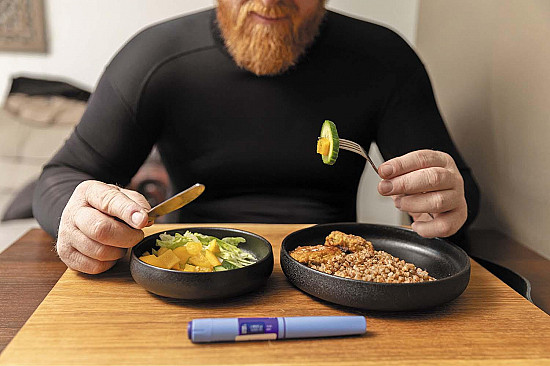An inside look at body fat
Keep tabs on visceral fat, the kind you cannot see or feel.
- Reviewed by Howard E. LeWine, MD, Chief Medical Editor, Harvard Health Publishing; Editorial Advisory Board Member, Harvard Health Publishing

As men age, their metabolism naturally declines and they burn calories more slowly. Testosterone levels drop, and they may be less active, leading to potentially less muscle mass and making calorie burning even more challenging. In addition, many men consume more daily calories than they need. The typical outcome: too much body fat.
"When you take in extra calories and don't burn them off, they eventually get stored as fat, and over time can accumulate," says Dr. Caroline Apovian, co-director of the Center for Weight Management and Wellness at Harvard-affiliated Brigham and Women's Hospital.
But the real problem is where this fat ends up. Many people think of "bad" fat as the kind they can pinch around their waist. But the fat that collects just under the skin — called subcutaneous fat — appears to cause few health issues.
A more dangerous type of fat, called visceral fat, is stored at waist level, but inside the abdominal cavity and around vital organs like the pancreas, liver, and intestines.
Visceral fat makes up only about 10% of a person's total body fat. Still, research has found that high amounts can raise several heart disease risk factors, such as blood pressure, blood sugar, and total cholesterol levels.
How to measure
How can you measure visceral fat? The most accurate way is with an MRI, but that can be expensive (and the test is not covered by health insurance if ordered solely to assess visceral fat). Body mass index (BMI) provides a reasonable estimate using a person's height and weight. (Find your BMI at /bmi.) But BMI does not account for ethnic differences, nor does it consider extra weight from muscle and bone mass.
One of the best (and easiest) ways to gauge visceral fat is your waistline, according to Dr. Apovian. "In general, a man whose waist measures 40 inches or more has excess visceral fat." (See "Waist management.")
But what if you have only put on an extra three to five pounds that moves the belt buckle over one hole? Is that a problem? Not necessarily—but be careful, warns Dr. Apovian. "It's easy for five pounds to quickly turn into 10 pounds, and the more extra weight you carry, the greater the risk for high amounts of visceral fat."
Waist managementA tape measure is a simple way to keep tabs on visceral fat. Place the bottom of the tape at the top of your right hipbone, then pull the tape around at navel level (not the narrowest part of your torso). Do not suck in your gut or pull the tape tight enough to compress the area. A waist circumference of 40 inches or more is considered a sign of excess visceral fat for men. Also monitor whether your pants get snug, which also can be a sign you have gained visceral fat. |
Going deep
The best way to fight the fat you cannot see is the same as for fat you can see—aerobic exercise, strength training, and a healthy diet. But keep in mind that visceral fat can be slow to come off. "You first gain visceral fat, and then you gain subcutaneous fat," says Dr. Apovian. "But when you lose weight, only about one-third is visceral fat."
Dr. Apovian recommends a combination of 30 minutes to an hour of moderate-intense aerobic exercise, two or three days a week, plus two sessions a week of weight or resistance training to add muscle mass. "The combination helps to burn calories and tap into stored visceral fat," she says.
The kind of aerobic exercise doesn't matter as long as the intensity raises your heart rate enough that it is difficult to have a conversation. Some of your aerobic workouts should include high-intensity interval training, or HIIT, Dr. Apovian adds.
With HIIT, you run or walk at a higher intensity for a brief time, followed by a period at a slower pace to catch your breath. You repeat the cycle for the entire workout. You can enlist a personal trainer to help design a HIIT program and teach you how to perform the exercises correctly and safely.
Besides following a healthy, plant-based diet, make sure you eat enough daily protein to help build muscle mass. The recommended daily intake is 0.8 grams per kilogram of body weight. (You can convert your body weight from pounds to kilograms by dividing by 2.2.
So, for instance, 160 pounds is 72 kg; multiplying this by 0.8 equals about 58 grams of protein a day.) Fish, poultry, beans, and yogurt are good protein sources. You can also mix protein powder into smoothies, oatmeal, or a glass of water or milk.
Image: © Elena Pimukova/Getty Images
About the Author

Matthew Solan, Executive Editor, Harvard Men's Health Watch
About the Reviewer

Howard E. LeWine, MD, Chief Medical Editor, Harvard Health Publishing; Editorial Advisory Board Member, Harvard Health Publishing
Disclaimer:
As a service to our readers, Harvard Health Publishing provides access to our library of archived content. Please note the date of last review or update on all articles.
No content on this site, regardless of date, should ever be used as a substitute for direct medical advice from your doctor or other qualified clinician.
















